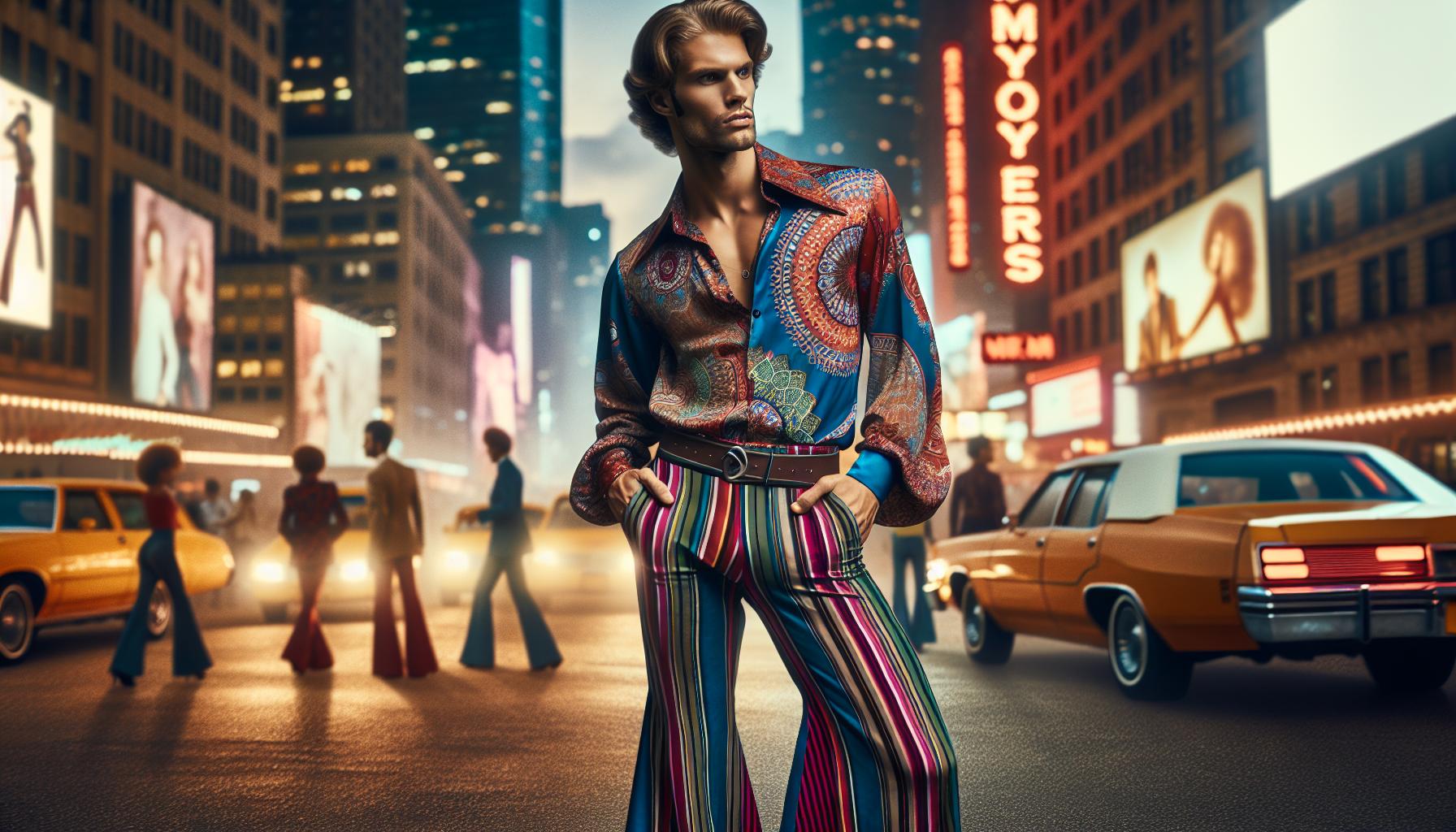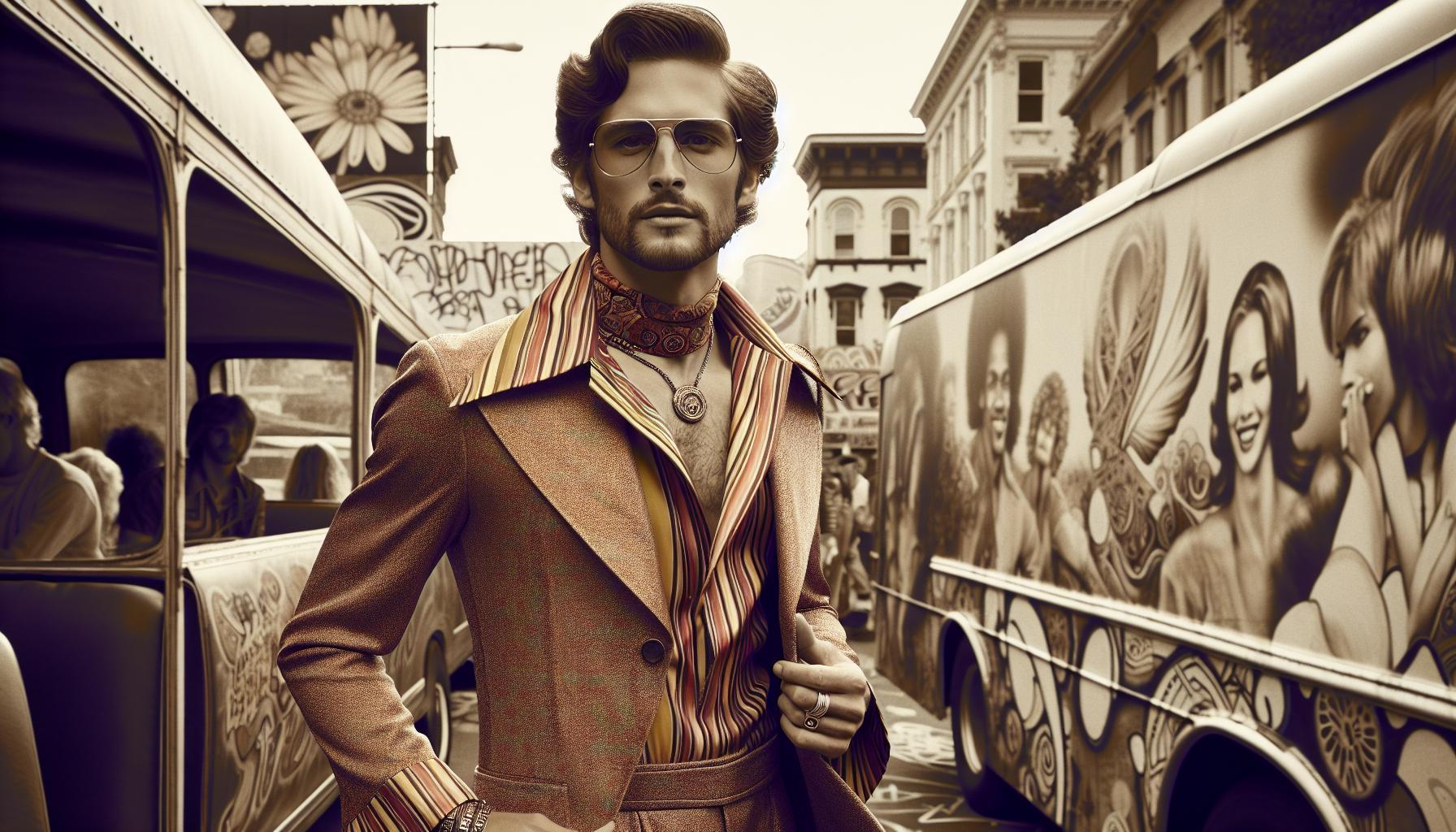Step into a time machine and zip back to the 1970s, where men’s fashion was as bold as a disco ball and as vibrant as a classic rock anthem. This was an era where flared pants and funky prints ruled the streets, and a man’s wardrobe was a canvas for self-expression. Gone were the days of stuffy suits; it was all about embracing individuality, whether that meant sporting a dazzling polyester shirt or a pair of platform shoes that could double as a weapon.
Imagine the confidence it took to strut down the street in a paisley jumpsuit or a wide-brimmed hat that could block out the sun and the judgment of the less daring. Men’s 70s fashion wasn’t just about looking good; it was about making a statement. So grab your bell-bottoms and let’s dive into the groovy world of 70s style, where every outfit tells a story and every man was a trendsetter.
Men’s 70s Fashion
Men’s 70s fashion featured bold colors and eclectic styles that reflected the spirit of the era. Flared pants became a staple piece, often paired with colorful, patterned shirts. Funky prints emerged as a popular choice, with paisley, tie-dye, and geometric designs dominating the landscape. Accessories played a crucial role in completing outfits, with wide belts, statement jewelry, and funky sunglasses enhancing the overall look.
Men boldly embraced platform shoes, which added height and flair to their ensembles. Textured fabrics like corduroy and velvet gained traction, providing a tactile element to clothing. Denim jackets and shirts showcased a rebellious attitude, often adorned with embellishments or patches. The notion of casual wear transitioned, allowing men to dress down while maintaining style.
Influences from music and pop culture greatly impacted fashion choices. Icons such as David Bowie and the Bee Gees inspired trends, showcasing versatility through their distinctive looks. Street fashion also played a role, as individuals experimented with unique styling and personalized outfits.
Hippie culture contributed to long hair and facial hair becoming fashionable for men, fostering a more androgynous aesthetic. This shift represented a departure from conservative norms, encouraging self-expression through fashion. Individuality was celebrated, with men mixing and matching styles to create their own looks.
Overall, men’s 70s fashion reflects a transformative period where clothing became a medium for personal expression. Style choices varied from flamboyant to laid-back, highlighting a diverse spectrum of influences that continue to resonate today.
Key Trends in Men’s 70s Fashion

Men’s fashion in the 1970s highlighted boldness and creativity, marked by distinctive styles that transformed personal expression.
Disco Influences
Disco culture defined a significant part of 70s fashion. Shiny materials like polyester and metallic fabrics gained popularity, creating a striking aesthetic on dance floors. Tailored suits, often adorned with vibrant colors and flamboyant patterns, became staples for both nightlife and everyday wear. Men embraced turtlenecks and fitted jackets, presenting a confident silhouette. Iconic figures such as John Travolta exemplified this trend, influencing countless individuals to adopt similar styles. Shoes played a crucial role, with platform heels enhancing height and charm. The disco era remains synonymous with daring and playful fashion choices.
Casual Wear Evolution
Casual wear evolved dramatically during the 70s, moving away from previous conservative styles. Comfortable fabrics like denim and corduroy gained traction, appearing in everything from shirts to jackets. The introduction of graphic tees allowed men to showcase interests and individuality. Influences from the hippie movement encouraged a laid-back approach, making items like loose-fitting pants and Hawaiian shirts popular choices. Accessories such as bucket hats and vibrant scarves complemented outfits, adding an element of fun. Overall, casual wear of the era reflected a blend of comfort and a relaxed attitude toward fashion.
Iconic Styles and Pieces

Men’s fashion in the 70s featured several iconic styles that defined the decade. From bold trousers to vibrant tops, each piece reflected a unique cultural moment.
Bell-Bottoms and Wide-Leg Trousers
Bell-bottoms emerged as a staple, characterized by their fitted upper and flared lower leg. This style allowed for freedom of movement, making them popular for dancing. Many wore wide-leg trousers made from comfortable fabrics, providing a relaxed silhouette. Styles often included colorful patterns or bold prints, emphasizing self-expression. Men paired these trousers with fitted tops to create contrast, enhancing the overall look. Popular figures like Jimi Hendrix showcased this iconic design, influencing many to adopt similar styles. Different washes and materials, particularly denim and corduroy, contributed to their versatility.
Printed Shirts and Turtlenecks
Printed shirts became essential in a man’s wardrobe during the 70s. Funky patterns, paisleys, and psychedelic designs represented the era’s spirit of creativity. Layering a turtleneck under a blazer created a sophisticated yet laid-back appearance. Many styles were crafted from soft, breathable fabrics, ensuring comfort while making a statement. Bright colors dominated the landscape, often paired with solid pants to balance the outfit. Those who embraced this style showcased their unique personalities through fashion choices. Influencers like David Bowie popularized the printed shirt, highlighting the decade’s artistic expression and flair.
Notable Designers of the Era

The 1970s showcased remarkable creativity in men’s fashion, marked by the influence of renowned designers who shaped the decade’s aesthetic.
Influence of High Fashion
Prominent designers like Yves Saint Laurent and Halston transformed men’s wardrobes. Yves Saint Laurent introduced the modern tuxedo, redefining evening wear with a more tailored fit. Halston became known for luxurious fabrics and sleek silhouettes, particularly his iconic jumpsuits. Designers embraced bold colors and dynamic prints, enabling men to express personality through clothing. Coco Chanel’s legacy also persisted, influencing styles that emphasized streamlined elegance. Notably, the wire-lace shirts popularized in high fashion inspired everyday trends, allowing men to fuse sophistication with casual wear.
Street Style Contributions
Street style emerged as a powerful force, reflecting diverse influences from art, music, and culture. Local tailors began creating custom garments that embodied personal flair. Influenced by rock and punk, many embraced leather jackets and graphic tees, leading to an informal yet edgy vibe. Influencers like Jimi Hendrix and David Bowie drove street fashion, popularizing flamboyant outfits and androgynous looks. Denim jeans gained popularity as versatile staples, often paired with colorful shirts and bold accessories. The rise of skate culture also shaped streetwear, promoting comfort and relatability in style choices.
Impact of Music and Pop Culture
Music and pop culture profoundly shaped men’s fashion in the 1970s. Icons like David Bowie and the Bee Gees established visual styles that became emblems of individuality. Their flamboyant outfits encouraged men to experiment with bold colors and unique patterns, resulting in a dynamic fashion landscape.
Rock and disco music not only influenced attire but also dictated lifestyle choices. Men sought to emulate their favorite artists, adopting looks like paisley shirts and flared trousers. Such clothing items became synonymous with personal expression, reflecting the era’s rebellious spirit.
Hippie culture played a pivotal role in changing perceptions of masculinity. Long hair and facial hair gained popularity, promoting a more androgynous aesthetic. The blending of casual and refined styles highlighted self-expression through diverse choices in clothing.
Shiny materials like polyester emerged as staples for nightlife. Disco culture’s emphasis on glitz and glamour transformed how men dressed for social events. Tailored suits often featured vibrant colors, pairing well with fitted tops for a polished yet fun look.
Significant designers, such as Yves Saint Laurent and Halston, contributed to this fashion evolution. They introduced luxurious fabrics and tailored fits that redefined men’s wardrobes. Street style, urban influences, and local tailors reflected personal flair and cultural shifts, broadening the spectrum of fashion.
Cultural movements and music trends forged connections between artists and their audiences. The incorporation of graphic tees allowed men to showcase their musical tastes, highlighting interests beyond fashion. This interlinkage established a whole new realm of creativity and individuality in men’s fashion during the 70s.
Fashion in the 70s
Men’s fashion in the 1970s was a vibrant tapestry of self-expression and individuality. This era encouraged bold choices and a departure from traditional styles. With influences from music and pop culture, men embraced eclectic looks that celebrated creativity and confidence.
The unique blend of casual and refined styles allowed for personal flair, making fashion an integral part of identity. As designers pushed boundaries, the impact of street style and cultural movements became evident. The legacy of 70s fashion continues to inspire contemporary trends, proving that true style is timeless and ever-evolving.

